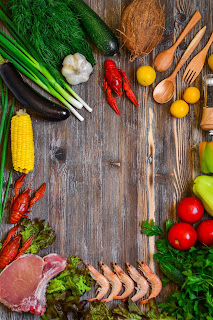Class 6th science chapter 2 note
Components of food
In this chapter-
What is nutrient?
Carbohydrates
Fats
Proteins
Vitamins
Minerals
Roughage and water
Balanced diet
Deficiency disease
What is nutrients?
Every days is made up of one or more ingredients.
The ingredients are the edible part of plants or animals which contains some compounds which are needed by our body called nutrients.
The major nutrients of our food are carbohydrates, fats, proteins, vitamins and minerals.
Roughage and water are also needed by our body.
Not all the food materials that we eat have the same nutrients.
Carbohydrates
There are many type of carbohydrate.
The main carbohydrates which are found in our food and in the form of starch and sugar.
It gives us energy to work so it is called energy giving food.
The food like rice, wheat, potato, sugar, sweet potato are rich in carbohydrates.
Fats
Our food items contents fat in the form of oil.
Fats are also the energy giving food.
Fats gives more energy than carbohydrates.
The food like coconut oil, mustard oil, sunflower oil, different nuts, ghee, butter, meat and milk content had in them.
Proteins
Proteins are needed for growth and repair of body.
Proteins are well known as the body building foods.
The food items like moong, peas, tuar dal, beans, soya beans, meet, fish, egg, milk and paneer are the rich source of protein.
Vitamins
Vitamins protect us from diseases and keep eyes, bones, skin, teeths and gums healthy.
There are different types of vitamins like vitamin A, vitamin B complex, vitamin C, vitamin D, vitamin E and Vitamin K.
Vitamin A keeps our eye and skin healthy.
Vitamin C fight against many diseases.
Vitamin D keeps our teeth and bone healthy.
The foods like papaya carrot mango and milk contains vitamin A.
Grains like wheat and rice contents vitamin B .
Fruits and vegetables like orange, lemon, tomato, amla, green chilli and guava contains vitamin C
Foods like milk, egg, butter and fish contains vitamin D.
Minerals
We need minerals in a small amount but these are very essential for our body.
It is required to maintain growth and good health.
Important minerals for our body are Iodine, Phosphorus, Iron and Calcium.
We can get iodine from ginger and salt, phosphorus from milk, banana and grains, iron from fruits and leaves and calcium from milk and eggs.
Roughage
Roughage and water do not provide any nutrients.
Roughage are also known as dietary fibres.
Roughage are mainly present in plant products.
Food like whole grain, pulses, potatoes, fresh fruits and vegetable contains roughage in it.
It adds extra bulk to the food and help in excretion of undigested food.
Water
Water is essential to absorb nutrients from food.
It helps in cleaning the waste of our body through urine and sweat.
Balance diet
Food which we eat in a day is our diet.
The diet having all the nutrients in the right proportion with roughage and water is called a balanced diet.
Deficiency diseases
If a person is not getting a particular nutrient for a long period of time then the person may suffer from thats nutrient deficiency.
The deficiency of one or more nutrients can lead to disease or disorders.
The disease that occur because of lack nutrients for long period of time called deficiency diseases.
Deficiency of protein cause stunter growth, swelling of face, discoloration of hair, skin diseases and diarrhoea.
Deficiency of both carbohydrate and protein cause weak body and growth of the body completely stops.
Deficiency of Vitamin a cause loss of vision and symptoms are poor vision, loss of vision in darkness, sometime complete loss of vision.
Deficiency of Vitamin B cause beribery and symptoms are weak muscles and very little energy to do work.
Deficiency of Vitamin C cause scurvy and its symptoms are bleeding gums, wound take long time to heel.
Deficiency of vitamin D causes rickets and the symptoms are bone become soft and bend.
In the deficiency of calcium bone and tooth decay occurs and its symptoms are week bones and tooth decay
In the deficiency of iodine goiter cause and its symptoms are glands in the neck a swollen and causes mental disability in childrens.
The deficiency of iron and causes anaemia and the symptoms is weakness.
The deficiency diseases can be prevented by taking balance diet.







Comments
Post a Comment